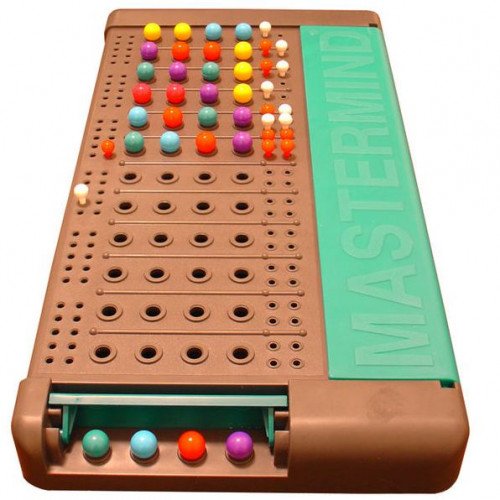MASTERMIND VS TWILIGHT STRUGGLE

MASTERMIND
Mastermind or Master Mind is a code-breaking game for two players. The modern game with pegs was invented in 1970 by Mordecai Meirowitz, an Israeli postmaster and telecommunications expert.It resembles an earlier pencil and paper game called Bulls and Cows that may date back a century. The game is based on an older, paper based game called Bulls and Cows. A computer adaptation of it was run in the 1960s on Cambridge University’s Titan computer system, where it was called 'MOO'. This version was written by Frank King. There was also another version for the TSS/8 time sharing system, written by J.S. Felton and finally a version for the Multics system at MIT by Jerrold Grochow. The modern game with pegs was invented in 1970 by Mordecai Meirowitz, an Israeli postmaster and telecommunications expert. Meirowitz presented the idea to many major toy companies but, after showing it at the Nuremberg International Toy Fair, it was picked up by a plastics company, Invicta Plastics, based near Leicester, UK. Invicta purchased all the rights to the game and the founder, Edward Jones-Fenleigh, refined the game further. It was released in 1971–2. Since 1971, the rights to Mastermind have been held by Invicta Plastics. (Invicta always named the game Master Mind.) They originally manufactured it themselves, though they have since licensed its manufacture to Hasbro worldwide, with the exception of Pressman Toys and Orda Industries who have the manufacturing rights to the United States and Israel, respectively. Starting in 1973, the game box featured a photograph of a white man in a white jacket seated in the foreground, with a young Asian woman of high caste standing behind him with the golden symbols of office visible on her sari, denoting the power and intellect behind the throne. The two amateur models (Bill Woodward and Cecilia Fung) reunited in June 2003 to pose for another publicity photo.
Statistics for this Xoptio

TWILIGHT STRUGGLE
Twilight Struggle: The Cold War, 1945–1989 is a board game for two players, published by GMT Games in 2005. Players are the United States and Soviet Union contesting each other's influence on the world map by using cards that correspond to historical events. The first game designed by Ananda Gupta and Jason Matthews, they intended it to be a quick-playing alternative to more complex card-driven wargames. It achieved critical acclaim for its well-integrated theme, accessibility and introduction of Eurogame elements. After being voted the number one game on BoardGameGeek from December 2010 to January 2016, it has been called "the best board game on the planet". Twilight Struggle is played competitively and was unofficially adapted for play-by-email and live online play. GMT released a Deluxe Edition in 2009, as well as a Collector's Edition as part of the crowdfunding campaign for the game's official adaptation into a video game; this Digital Edition was released in 2016. With over 100,000 copies sold, the game is GMT's all-time best-seller. According to its designers, "Twilight Struggle basically accepts all of the internal logic of the Cold War as true—even those parts of it that are demonstrably false." The game board thus presents a map of a bipolar world according to domino theory, where the US and USSR spread influence to all other countries (except China, which is shown as a powerful card, which must be handed to the other player if used, representing China tilting from one bloc to the other), and attempt to establish control depending on the stability of a country. One scholarly analysis proposed that "hile Twilight Struggle is at its core an area control game, what set its apart from being marked as a Risk clone is the combined effect of material aesthetics and design mechanics meant to embrace a particular point of view tied to the Cold War zeitgeist." Gameplay is divided into ten turns. Each turn players randomly draw a hand of event cards from a single deck. The starting deck contains only early war cards, with historically appropriate mid war and late war events shuffled in on turns 4 and 8 (for a total of 103 cards in the first edition). Players both use a card in the turn's headline phase (in which each player must play a card for its event) and six to eight action rounds.